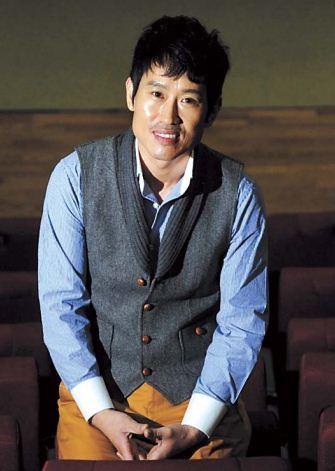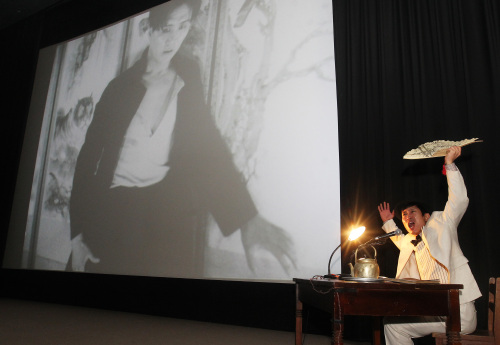
Actor Cho Hee-bong performs oldest surviving Korean silent film ‘Crossroads of Youth’
What would it have been like to watch a silent film with live narration and music?
Today’s moviegoers were given an opportunity to watch Korea’s oldest surviving silent film, “Crossroads of Youth.” last week, accompanied by live music and narration ― all in the 1930s style. Just like the “silent era” in the 20s and 30s, they saw and heard a “byeonsa” ― Korean term for silent-film narrator ― “performing” each and every action of the histrionic piece first released in 1934.
Last week’s screenings ― which were held at the Korean Film Archive in Sangam-dong, Seoul ― were to celebrate the movie’s designation as cultural heritage last month.
“I actually thought the movie would date back to an earlier period,” said actor Cho Hee-bong, who has been playing the new “byeonsa” for the film since 2008. “It in fact surprised me that our oldest surviving silent film dates back to only 80 years or so.”
The film, which deals with struggling young souls in ‘30s Korea, was discovered in 2007 by Korean Film Archive ― a government-affiliated institution devoted to collecting and preserving Korean films. That year the organization received a roll of unknown film from a man whose mother used to run Dansungsa, the first movie theater in Korea which opened in 1907. Along with two other major movie theaters in Seoul at the time ― Woomigwan and Chosun Movie Theater ― Dansungsa had about six byeonsa who performed on a daily basis throughout the 1920s and 30s.
What would it have been like to watch a silent film with live narration and music?
Today’s moviegoers were given an opportunity to watch Korea’s oldest surviving silent film, “Crossroads of Youth.” last week, accompanied by live music and narration ― all in the 1930s style. Just like the “silent era” in the 20s and 30s, they saw and heard a “byeonsa” ― Korean term for silent-film narrator ― “performing” each and every action of the histrionic piece first released in 1934.
Last week’s screenings ― which were held at the Korean Film Archive in Sangam-dong, Seoul ― were to celebrate the movie’s designation as cultural heritage last month.
“I actually thought the movie would date back to an earlier period,” said actor Cho Hee-bong, who has been playing the new “byeonsa” for the film since 2008. “It in fact surprised me that our oldest surviving silent film dates back to only 80 years or so.”
The film, which deals with struggling young souls in ‘30s Korea, was discovered in 2007 by Korean Film Archive ― a government-affiliated institution devoted to collecting and preserving Korean films. That year the organization received a roll of unknown film from a man whose mother used to run Dansungsa, the first movie theater in Korea which opened in 1907. Along with two other major movie theaters in Seoul at the time ― Woomigwan and Chosun Movie Theater ― Dansungsa had about six byeonsa who performed on a daily basis throughout the 1920s and 30s.

“The donor had kept the film in good condition as his mother told him to, not even knowing what the film was about,” said programmer Mo Eun-young from Korean Film Archive. “He brought it to us as he was curious to find out what it contained. When we got it developed, it turned out to be director Ahn Jong-hwa’s ‘Crossroads of Youth.’”
Though director Ahn had left a very brief summary of the silent movie, there was no remaining script. Mo asked “Late Autumn” and “Family Ties” director Kim Tae-yong to re-direct the film into a Byeonsa performance, and Kim asked Cho to star in it. The trio together wrote a new script for the film after watching the silent movie countless times. It took them about a month finish, and Cho said the process was so tedious that he often wanted to jump out of the building.
“Well, on top of everything else, it was extremely boring to watch a silent film and read the lips of each and every character over and over again,” Cho told The Korea Herald. “At first it was hard to even differentiate the female characters from each other. They all looked very similar to me.”
The film, along with Cho’s narration, was first screened in 2008 at the Korean Film Archive, in celebration of the institution’s opening of the current Sangam-dong office building. Cho was invited to perform for the film for New York Film Festival in 2009, Mexico’s Guwahati International Film Festival in 2011, and the Thames Festival in London in 2011.
“The most memorable performance was the one in Mexico,” said Cho. “They were very enthusiastic. I could tell that they were just enjoying the whole performance without thinking too much about what’s so Korean or foreign about the movie.”
Cho said his byeonsa performance isn’t exactly the work of director Ahn Jong-hwa. “Director Kim Tae-yong pretty much recreated the piece, and really, this is his work,” he said.
“We wanted this piece to be socially-conscious. So back in 2008, Kim and I included a line that says something about mad cow disease which was a huge public concern at the time. For this year’s performance, we talk about private debt lenders and debts, which has become a serious issue these days. In fact one of the female characters is forced to marry someone rich because of her father’s debt. We wanted to link the past and the present somehow.”
Cho said he is not interested in making the film into a talkie by recording his narration.
“I’ve once said something like, ‘I’m not ready to send this movie to a museum yet,’” said Cho. “I think I want to continue this byeonsa performance as much as I can, because I see too many similarities between this movie and what’s happening now. The film’s leading character, who is young and oppressed, isn’t so different from our young people living in 2012.”
“Crossroads of Youth” will be screened again in Busan with Cho’s narration and live music at Busan Cinema Center on March 25. It also may be screened during the upcoming London Olympics Games in July, the Korean Film Archive said.
By Claire Lee (dyc@heraldcorp.com)




![[Herald Interview] 'Amid aging population, Korea to invite more young professionals from overseas'](http://res.heraldm.com/phpwas/restmb_idxmake.php?idx=644&simg=/content/image/2024/04/24/20240424050844_0.jpg&u=20240424200058)














![[Today’s K-pop] Kep1er to disband after 2 1/2 years: report](http://res.heraldm.com/phpwas/restmb_idxmake.php?idx=642&simg=/content/image/2024/04/25/20240425050792_0.jpg&u=)